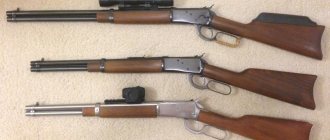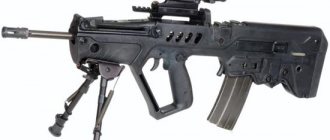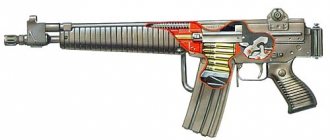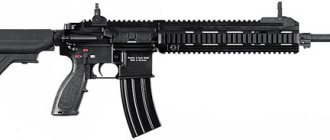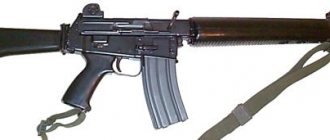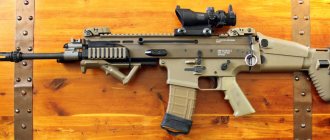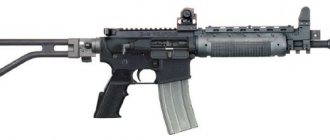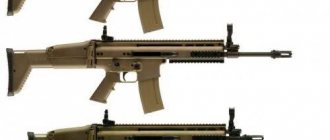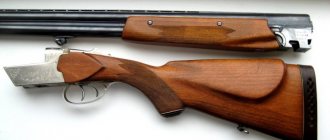Talk about Sturmgewehr: The first “assault rifle”
How often we pronounce the term “ assault rifle ,” but few people think about the origins of the birth of this term. This term was first used in German. Sturmgewehr - this is the name, according to rumors, that Hitler himself gave to a promising model of weapons from the company CG Haenel .
Have you heard of this one? But it was this company that belonged to Hugo Schmeisser, the leading design engineer who took on the contract from the Wehrmacht for an automatic carbine chambered for a new intermediate cartridge. The new weapon received the abbreviation MKb.
The content of the article
Sturmgewehr: the first "assault rifle"
It should be noted that work on this project began in 1938, and already in 1940 Schmeisser handed over the first samples chambered for 7.92x33 mm Kurz for testing. In the same year, in parallel with Haenel, ]Walther[/anchor] began similar developments.
In 1942, both companies presented their designs. The Walther prototype was immediately disqualified due to the complexity of the design, and, as a result, the high cost of production. Schmeisser advanced to the next round. But with the following conditions:
- replace the trigger with a Walter trigger system, which is reliable and provides greater accuracy of combat with single shots;
- change the sear design;
- equip a safety lever instead of safety by inserting the reloading handle into the transverse groove of the receiver, familiar to MP 38/40 submachine guns;
- make the gas chamber tube shorter;
- replace the large cross-section windows for the escape of residual powder gases from the gas chamber tube with 7 mm holes, to increase the reliability of the weapon when operating in difficult conditions;
- introduce technological changes in the bolt and bolt carrier with a gas piston;
- remove the guide bushing of the recoil spring;
- remove the bayonet lug due to a revision of the tactics of operating the machine gun and the adoption of the Gw.Gr.Ger.42 grenade launcher with a different method of mounting on the barrel;
- simplify the design of the butt.
At the beginning of 1943, the name of the weapon MKb42(H) was changed to MP 43A (German: Maschinenpistole - submachine gun). This designation served as a kind of disguise, since Hitler did not want to produce weapons of a new class. And after modification under the designation MP43, this weapon model was delivered to the troops in a small batch. To the eastern front. Then everything that was going to be adopted by the Wehrmacht was tested on the Eastern Front. And they gave it to be tested by the most severe, in the opinion of the General Staff, guys - soldiers of the 5th SS Panzer Division "Wiking" (5. SS-Panzer-Division "Wiking"). The Vikings rated this weapon very highly, but(!) asked for it to be modified a little. And we must pay tribute to Speer, who provided Schmeisser with every possible protection - without him, the future “assault rifle” would not have been able to undergo testing in combat.
It turned out that the use of MP43 reduces the dependence of infantry squads on machine gunners, and as a result, the individual effectiveness of each soldier increases.
Hitler and the StG.44 assault rifle
The new weapon was demonstrated to Hitler. Prior to this, he received a large number of excellent reviews about him from SS generals, Speer personally and the leadership of the German military-industrial complex. It should be noted that Adolf was not enthusiastic about the idea of rearmament of the Wehrmacht at that stage of the war. German industry was clearly not keen on such projects, and he was partly right. In addition, he was afraid that there would be a bunch of now unclaimed weapons and ammunition in the warehouses.
It is believed that the final name of this automatic rifle - “assault rifle” or StG.44 - was invented personally by the Fuhrer, just at the moment of demonstrating to him the already tested MP43. Sturmgewehr itself was given not so much to resolve confusion in the classification, but rather to promote the new “miracle weapon”.
Thus, on April 6, 1944, the Supreme Commander issued an order where the name MP 43 was replaced by MP 44, and in October 1944 the weapon received the fourth and final name “assault rifle” - Sturmgewehr StG.44.
Assembly plants primarily used materials from the stock. Thus, on some samples of 1945, the designations MP44 are found, and the assembly date can only be determined by the numbers.
The first owners of the StG.44 were, again, the guys from the Waffen-SS, who they tried to equip with the highest quality weapons and equipment. By that time, SS divisions very often played the role of “fire brigades” at the front. They were sent to where the largest enemy breakthrough was planned, etc. However, throughout the entire period of use of this assault rifle, there was a catastrophic shortage of ammunition. Thus, a report from the high command of the ground forces dated June 16, 1944 stated that the MP44 would become the standard infantry weapon only if the problem with ammunition was resolved.
Other problems remained unresolved: firstly, the lack of a handguard. The barrel casing, made of metal, became very hot during intense shooting, which is why during aimed shooting the brave Bavarian guys were forced to hold on to the magazine shaft. The second problem is a weak magazine spring, which sagged over time. The third is the weight of the StG.44, which was 5.2 kg, which was significantly more than the weight of a standard Wehrmacht infantry rifle. Fourth: fragile receiver.
Despite these disadvantages, the StG.44 turned out to be a completely universal infantry weapon with a cartridge that had excellent characteristics for that period of time - it showed excellent accuracy results at short and medium distances and a good rate of fire.
They tried to make the StG.44 the most universal infantry weapon; all sorts of additional sighting devices were installed on it, from the completely standard ZF4 (or ZF41) to the ZG.1229 “Vampire” infrared sight. For the Sturmgever they even developed special attachments for shooting from around the corner Krummlauf Vorsatz J. Sometimes it seems to me that the German designers, feeling the frosty breath of the northern fur-bearing animal on the back of their heads, finally had as much fun as they could. Separately, I would like to draw your attention to the fact that the StG.44 is available both with and without a bayonet mount.
And now we move on to the most delicious...
Scope of delivery Sturmgewehr StG.44
The StG.44 delivery set consisted of six magazines, a machine for filling magazines with cartridges, a belt, three barrel covers, a tool for unscrewing the gas chamber and removing the trigger guard, spare parts such as an extractor, extractor springs, etc., and a pencil case with a brush on a cord for cleaning the barrel, technical instruction manual.
The device of the StG.44 assault rifle
and this paragraph will consist almost entirely of quotes:
Automation StG.44 is a gas vent type with removal of powder gases through a hole in the barrel wall. The barrel bore is locked by tilting the bolt in a vertical plane. The skew is carried out by the interaction of inclined planes on the bolt and bolt frame. Gas chamber - without the possibility of regulation. The gas chamber plug with the auxiliary rod is unscrewed with a special drift only when cleaning the machine. To throw rifle grenades it was necessary to use special equipment. cartridges with 1.5 g (for fragmentation grenades) or 1.9 g (for armor-piercing cumulative grenades) powder charge. The standard weight of gunpowder in the 7.92x33 Kurz cartridge is 1.57 g. A gas piston with a rod is connected to the bolt stem.
The trigger mechanism is trigger type. The trigger mechanism allows single and automatic fire. The fire selector is located in the trigger box, and its ends extend outward on the left and right sides in the form of a button with a corrugated surface. To conduct automatic fire, the translator must be moved from left to right to the letter “D”, and for single fire - from right to left to the letter “E”. The Sturmgewehr StG.44 is equipped with a safety device against accidental shots. This flag-type fuse is located below the fire selector and in the position at the letter “F” it blocks the trigger lever. The return spring is located inside the stock, thereby eliminating the possibility of simply creating a variant with a folding stock.
Ammunition is supplied from a detachable sector double-row magazine with a capacity of 30 rounds. Typically, 30-round magazines were equipped with 25 rounds due to the weakness of the springs, which did not always ensure a normal supply of cartridges when the magazine was fully loaded. In March 1945, a magazine with a capacity of 25 rounds was included in the list of accessories for the MP 44, but it is unlikely that such magazines were made in large quantities. Also in March 1945, at the infantry school in Döbritz, a stopper was created for a 30-round magazine, limiting its filling to 25 rounds.
The rifle's sector sight allows for targeted fire at a distance of up to 800 m. The sight divisions are marked on the sighting bar. Each division of the sight corresponds to a change in range by 50 m. The slot and front sight are triangular in shape.
Results
Now I will not draw parallels between the StG.44 and the AK, which some readers are waiting for, I will only say one thing: considering Hugo Schmeisser the father of the AK is like considering Koshkin the father of the Panther and saying that the Panther was copied from the T-34.
The StG.44 served well on the battlefields of World War II and continued to serve afterwards. For example, a certain amount of StG.44 was produced by Attchinsson and was used to a limited extent by the US Armed Forces in the Korean War. What can I say, the Sturmgewehr StG.44 appears on video from time to time in various conflicts in the Middle East.
Generally speaking, the Sturmgever had a huge impact on the modern small arms industry, becoming the starting point for many design schools.
Dmitry Migalin | Author's articles on military topics
1943-1944
The modified model was already listed in the documentation as MP-43A. It soon entered service with the German army and was supplied to the Eastern Front for soldiers of the 5th SS Wiking Panzer Division. In 1943, German industry produced over 14 thousand units of such weapons. In 1944, a new abbreviation was provided for the model - MP-44. Some historians suggest that it was Hitler who renamed the MP-44 to the Stumgever STG 44.
The characteristics of the first German assault rifle were appreciated by the Nazis. The use of such weapons had a positive effect on the firepower of the German infantry. Selected units of the Wehrmacht and Waffen-SS were armed with German assault rifles (Sturmgewehr) STG 44. By the end of the war, Germany had produced at least 400 thousand weapons. However, these models began to be widely used in the final phase of World War II. The reason for this was the shortage of cartridges for the German STG 44 assault rifle. Photos of the cartridges are presented in the article. According to military experts, the lack of ammunition prevented the weapon from having a major impact on the course of World War II.
About the German rifle and the Soviet Kalash
According to military experts, the German STG 44 assault rifle and the AK are very similar. In 1945, the Americans occupied the city of Sühl. It was in this city that the company of H. Schmeisser was located. Having made sure that the businessman was not a Nazi, the Americans did not detain him, and showed absolutely no interest in STG 44. US soldiers were convinced that their M1 automatic carbines were superior to German rifles.
In the Soviet Union, work on the creation of an intermediate cartridge has been carried out since 1943. The impetus for this was the appearance of captured rifle models among Soviet designers. In 1945, all technical documentation on the assault rifle was removed from Schmeisser's enterprises in the USSR.
In 1946, 62-year-old Hugo Schmeisser and his family went to the Soviet Union, namely to Izhevsk. In this city, Soviet designers carried out work to create a new machine gun. A German gunsmith was invited to the enterprise as an expert. Soviet designers used technical documentation for the German Schmeisser assault rifle. It is for this reason that debates about the origin of the Soviet “Kalash” are still raging among specialists and amateurs of automatic small arms. Some argue that the AK is a successful copy of the STG 44.
About the advantages and disadvantages
According to experts, the STG 44 is a revolutionary example of automatic small arms. The rifle has the following advantages:
- Excellent accuracy of hits when shooting at close and medium distances.
- Compactness. The rifle was very easy to use.
- Excellent rate of fire.
- Good ammunition characteristics.
- Versatility.
Despite the presence of undeniable advantages, STG 44 is not without some disadvantages. The weaknesses of the rifle include:
- The presence of a weak magazine spring.
- Unlike other rifle models, the STG 44 has a large mass.
- The presence of a fragile receiver and unsuccessful sighting devices.
- The German assault rifle does not have a handguard.
According to military experts, these shortcomings were not critical. By carrying out a small modernization, the weaknesses of the German rifle could be easily eliminated. However, the Nazis no longer had time for this.
About grenade launchers
The Wehrmacht Armament Directorate formulated a requirement that an assault rifle must be suitable for firing grenades. The first models of weapons were characterized by the presence of a special thread on which flame arresters were mounted. They decided to use the threaded mount to install grenade launchers on German STG 44 assault rifles. The characteristics of the weapon turned out to be insufficiently reliable for this. It turned out that such a design was futile. In order to adapt the grenade launcher to the assault model, a batch of rifles (MP 43) was developed, in which the front part of the barrel contained a special ledge. In addition, the pedestals for the front sights had to be redone.
The installation of grenade launchers became possible only after these design modifications were completed. Since ammunition for grenade launchers, unlike rifle grenade launchers, was represented by a wide range, the designers faced a problem due to the lack of a special expulsion cartridge. Since during the use of automatic weapons, powder gases are consumed when feeding ammunition, the required pressure was not enough to fire a grenade from a rifle. The designers should have developed a special device.
In 1944, two expelling cartridges were created: one with a charge of 1.5 g was intended for firing fragmentation grenades, and the second with a charge of 1.9 g was intended for armor-piercing cumulative grenades. In 1945, the weapon was successfully tested. However, according to experts, special sights should also be developed for rifles that fire grenades, which was never done.
Using pistols
In the USSR, pistols were developed almost from scratch. In 1931, the history of the Russian Tokarev TT pistol began. It was credited with reliability, lightness, compactness, simple design, easy maintenance and overall unpretentiousness. The TT itself was very powerful, but had many shortcomings - terrible ergonomics, poor magazine fastening, cases of self-inflicted gunfire. Because of this, the weapon has undergone some modifications.
The pistol was put into mass production in 1933, having changed the details of the barrel, trigger mechanism and frame. The destruction distance after modifications was 50 meters, the maximum bullet range was 800-1000 m. Over the entire period from adoption to the end of production in the mid-50s, more than 1.7 million units were produced.
The Luger 9mm, which was in German service, was converted from a Borchardt pistol back in 1900. According to the reports of some modern historians, it was one of the best pistols at the time of World War 2 - highly accurate, ergonomic and reliable. However, it had a significant drawback - it became clogged too quickly due to the inability to close the locking levers. Because of this, problems arose during subsequent shooting.
About curved-barrel devices
Assault rifles were adapted for shooting from trenches and from behind tanks. Such firing became possible thanks to the presence of special curved-barrel attachments. The service life of such devices did not exceed 250 shots. Initially it was planned to use 7.92x57 mm rifle ammunition. But during testing it turned out that the power of such cartridges was too great for curved-barrel attachments, which failed after only a hundred shots. The gunsmiths decided to use 7.92x33 mm cartridges.
1944 was the year the first curved-barrel device for an assault rifle appeared. The nozzle was presented in the form of a rifled barrel bent at 90 degrees. Special openings were provided for the product through which powder gases escaped. The designers managed to increase the service life of the nozzle, compared to the first samples, to 2 thousand shots. A bevel angle of 90 degrees was provided. However, the German infantrymen were not satisfied with this indicator of curvature. The designers had to change the angle to 45 degrees. However, after the tests, it turned out that such a bevel angle entails rapid wear of the nozzles. As a result, the curvature had to be reduced to 30 degrees. With the help of these devices, German soldiers could also fire grenades. Especially for this purpose, the holes in the nozzles were covered, since a large amount of gases was required for the grenade to fly out. The firing range of the rifle grenade launcher was 250 m.
In 1945, the curved-barrel attachment Deckungszielgerat45 was manufactured. With the help of this device, the German soldier had the opportunity to shoot grenades from a full-fledged shelter. The device was a frame to which a rifle was attached using special latches. The lower part of the frame was equipped with an additional metal butt and a wooden pistol grip. Its trigger mechanism was connected to the trigger of the rifle. Aiming was carried out using two mirrors installed at an angle of 45 degrees.
TTX
- STG 44 refers to automatic weapons.
- Weight – 5.2 kg.
- The size of the entire rifle is 94 cm, the barrel is 419 mm.
- The weapon fires 7.92x33 mm ammunition. Caliber 7.92 mm.
- The projectile weighs 8.1 g.
- The fired bullet has a speed of 685 m/s.
- Automation uses the principle of removal of powder gases.
- The barrel channel is locked by tilting the bolt.
- The aimed shooting range is 600 m.
- Ammunition supply sector store.
- Within one minute you can fire up to 500-600 shots.
- Country of origin: Third Reich.
- The rifle was created by designer Hugo Schmeisser.
- The rifle entered service in 1942.
- The total number of rifle units produced is 466 thousand.
Special weapons
In addition to the main small arms, the warring parties used all kinds of grenades, machine guns, anti-tank rifles and other means to fight the enemy. In particular, the following were widely used:
- grenades - F-1 and Stielhandgranate;
- machine guns - MG-42, DP-27 and Maxim;
- anti-tank rifles - PTRS, PTRD and PzB-38;
- "Molotov cocktails".
Stielhandgranate - an anti-personnel hand grenade, a symbol of the Wehrmacht, was a favorite trophy of both the Allies and Soviet soldiers, as it was very safe and convenient. At the time of the war, it was the only explosive completely protected from self-detonation. However, it also had disadvantages, for example, frequent leakage, which made it impossible to use.
The Soviet F-1 hand-held defensive anti-personnel grenade has been in service for about 70 years. And it will be used for a long time, since it has a wide range of advantages - high explosion power, reliability and simplicity, low cost of production. The negative aspects include a weak fragmentation effect, a remote fuse and too much weight.
Contrary to popular belief, the Molotov Cocktail was not invented by Soviet soldiers. For the first time, a similar bottle filled with an incendiary mixture was used during the Cuban War of Independence. And in the Red Army it was used by the 100th Rifle Division of the Red Army in 1941 during the defense of Minsk.
Machine guns, Soviet and German: the famous MG-42, the reliable DP-27 and the old Maxim were indispensable in supporting infantry and performing a variety of combat missions. They were heavy, but this drawback was more than compensated by their rate of fire and relative simplicity.
Each weapon contributed to the way war was fought. And no matter how bad the fact of the conflict was, it gave a huge impetus to improving the production technologies of a wide variety of weapons. The transition from the old single-shot rifles to automatic carbines, which are still used today, is a major milestone in the history of weapons development.
Device Description
The rifle is equipped with a gas-operated type of automatic operation. Powder gases are discharged through special holes in the barrel. The barrel channel is locked by tilting the bolt. The rifle is equipped with a non-adjustable gas chamber. If it is necessary to clean the machine, the chamber plugs and the auxiliary rod are unscrewed. A special punch is provided for this procedure. The German assault rifle STG 44 is equipped with a trigger-type trigger. The weapon is designed for single and burst firing. The mode is regulated by a special translator, the location of which is the trigger guard. The ends of the translator are located on both sides of the receiver and are designed in the form of buttons with a corrugated surface. In order to fire in bursts from the German STG 44 assault rifle, the translator should be installed in position D. Single fire is possible in position E. In order to protect the owner from unplanned shots, the designers equipped the weapon with a safety lever, which is located on the receiver below the translator. The trigger lever is locked if the safety is set to position F. The inside of the butt has become the location for the return spring. This design feature of the rifle eliminates any possibility of designing modifications with a folding stock.

